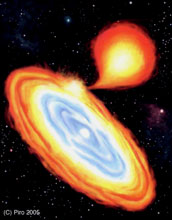Multimedia Gallery
Neutron Star Accreting Matter
Neutron Star Accreting Matter
An artist's rendering of a neutron star accreting matter from a red giant star. The red giant (on the upper right) is expanding and dumping material onto the neutron star. This material forms a disk and then finally falls to the neutron star surface.
A new theoretical thermometer built from heavy-duty mathematics and computer code suggests that the surfaces of certain neutron stars run significantly hotter than previously expected. Hot enough, in fact, to at least partially answer an open question in astrophysics: how to explain the observed frequency of ultra-violent explosions--known as superbursts--that sometimes ignite on such stars' surfaces?
"This is the first model that goes into some reasonable detail about the nuclear physics that occur in the crusts of accreting neutron stars," said Hendrik Schatz, NSCL professor and co-author of a paper that will be published in The Astrophysical Journal in June 2007. One of Schatz's co-authors, NSCL assistant professor Ed Brown, presented the results April 17, 2007, at a meeting of the American Physical Society in Jacksonville, Fla.
This work was supported in part by a National Science Foundation grant (PHY 02-16783) for the Joint Institute for Nuclear Astrophysics. The Physics Frontier Center JINA (Joint Institute for Nuclear Astrophysics) at the University of Notre Dame, Michigan State University, the University of Chicago, and Argonne National Laboratory provides an intellectual center with the goal to enable swift communication and stimulating collaborations across field boundaries and at the same time, provides a focus point in a rapidly growing and diversifying field. (Date of Image: 2007)
Credit: Tony Piro, University of California, Berkeley
Special Restrictions: Make sure this image is credited properly in all instances of use (see "Credit" line at end of caption, above).
Images and other media in the National Science Foundation Multimedia Gallery are available for use in print and electronic material by NSF employees, members of the media, university staff, teachers and the general public. All media in the gallery are intended for personal, educational and nonprofit/non-commercial use only.
Images credited to the National Science Foundation, a federal agency, are in the public domain. The images were created by employees of the United States Government as part of their official duties or prepared by contractors as "works for hire" for NSF. You may freely use NSF-credited images and, at your discretion, credit NSF with a "Courtesy: National Science Foundation" notation.
Additional information about general usage can be found in Conditions.
Also Available:
Download the high-resolution JPG version of the image. (241 KB)
Use your mouse to right-click (Mac users may need to Ctrl-click) the link above and choose the option that will save the file or target to your computer.

